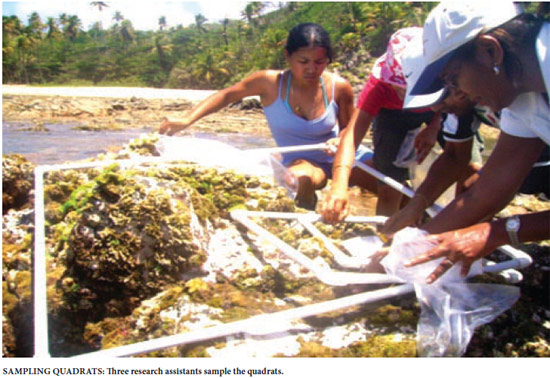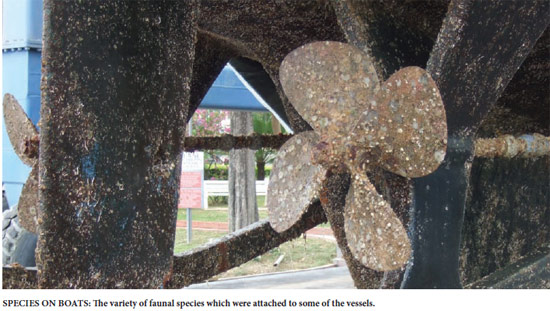 |
 |
 |
|
December 2010
|
Looking for aliens and other speciesby Dr. Judith GobinDr. Judith Gobin has been recently working on two major projects, here she tells us a bit about the field sampling for them Rocky shore species diversity (NAGISA project)
Leaving the University, the team (me and at least three assistants) endures the pleasant but long drive to Salybia, Toco. The time of departure is based on the low tide chart and we often need to be there by 7am which means starting off at around 5am. This invariably includes stoppage time for doubles or aloo pies along the way. Once there, the sampling gear comes out. Everyone knows his or her job and we are all prepared to get wet. (In the photograph, three research assistants are sampling the quadrats (eg. 1m x 1m).) They are using prepared data sheets to fill in data such as: % cover for different species, numbers of species, species names, etc. Depending on the measurements or observations we need to make, the sampling may be extractive (where we actually take specimens away). These samples will be for taxonomic identification and/or verifications, and weights (these values may be used to determine productivity). Photographs of all quadrats are taken and the GPS location is noted; with all data compiled before leaving the field. After a hard (and long) day on the coast, the job is far from complete. Back at the laboratory, all specimens (plant and animal) must be prepared or preserved for future measurements and examinations, weights noted, etc. At a later date the specimens will be identified and catalogued and eventually placed in the Department’s museum. Invasive/alien species project
Our team surveyed (and sampled) approximately 32 recreational vessels arriving at two marinas (Peakes and Power Boats) in Chaguaramas. These vessels originated in countries such as Australia, France, the USA, Ireland, etc. As the vessels were hauled onto dry dock, the team was allowed to scrape areas of the hulls (removing attached fauna and flora), take photographs and interview the boat’s custodian. The structured interview contributed information on the make of boat, origin and itinerary (including port stops) of the vessel including cleaning activities. All samples were placed in plastic bags and preserved in the field. The photograph shows the variety of faunal species which were attached to some of these vessels. They include barnacles, mussels, worms, arthropods and crustaceans, algae, sponges, soft corals, bryozoans etc. A complete data set (including determination of alien species) is being compiled. To date results suggest that alien species coming to our waters from Australia, France, the United Kingdom, Spain, etc. are indeed using marine vessels as a pathway, hitching a ride. Field sampling in the marine environment (the rocky shore as above) is very important for us to acquire knowledge about our tropical environments. It provides us with data and knowledge on: biological diversity (which we are still updating, eg. the CoML program), organisms and their interactions (eg. species interactions) and good baseline information. Such baseline information becomes extremely useful when there are episodic events such as the recent massive oil spill in the Gulf of Mexico (GoM). For example, the impacts of oil pollution on proximal GoM rocky shores could be determined by comparison of data from a “pre-spill” survey with that of a “post-spill” data set. Additionally, data from the Invasive species project will assist Trinidad and Tobago in better understanding the impacts of invasive species on local ecology and with the development of a management strategy. |

 A typical field sampling day starts at the crack of dawn – packing gear for snorkeling, scuba diving and sampling (like quadrats, forceps, YSI meters (to measure pH, salinity, dissolved oxygen, etc.), plastic containers, alcohol for preserving specimens, camera, GPS, notepads, data sheets.).
A typical field sampling day starts at the crack of dawn – packing gear for snorkeling, scuba diving and sampling (like quadrats, forceps, YSI meters (to measure pH, salinity, dissolved oxygen, etc.), plastic containers, alcohol for preserving specimens, camera, GPS, notepads, data sheets.). Invasive/alien species (those that do not naturally belong to an area) pose serious threats to all marine and coastal environments. Marine vessels (ranging from oil and gas tankers to recreational yachts) continuously bring such aliens to Trinidad and Tobago and this may have considerable negative impacts on our ecosystems. Alien species are known worldwide to compete for resources (food, light, oxygen, space) and their survival and success cause disruptions in the overall ecosystem structure (such as relationships between organisms). Here in Trinidad and Tobago, two well-known marine invasives are the green mussel (Perna viridis) which was possibly introduced attached to ships (or in ballast waters) and the tilapia fish (Tilapia mossambica) which was released accidentally from fish farms.
Invasive/alien species (those that do not naturally belong to an area) pose serious threats to all marine and coastal environments. Marine vessels (ranging from oil and gas tankers to recreational yachts) continuously bring such aliens to Trinidad and Tobago and this may have considerable negative impacts on our ecosystems. Alien species are known worldwide to compete for resources (food, light, oxygen, space) and their survival and success cause disruptions in the overall ecosystem structure (such as relationships between organisms). Here in Trinidad and Tobago, two well-known marine invasives are the green mussel (Perna viridis) which was possibly introduced attached to ships (or in ballast waters) and the tilapia fish (Tilapia mossambica) which was released accidentally from fish farms.